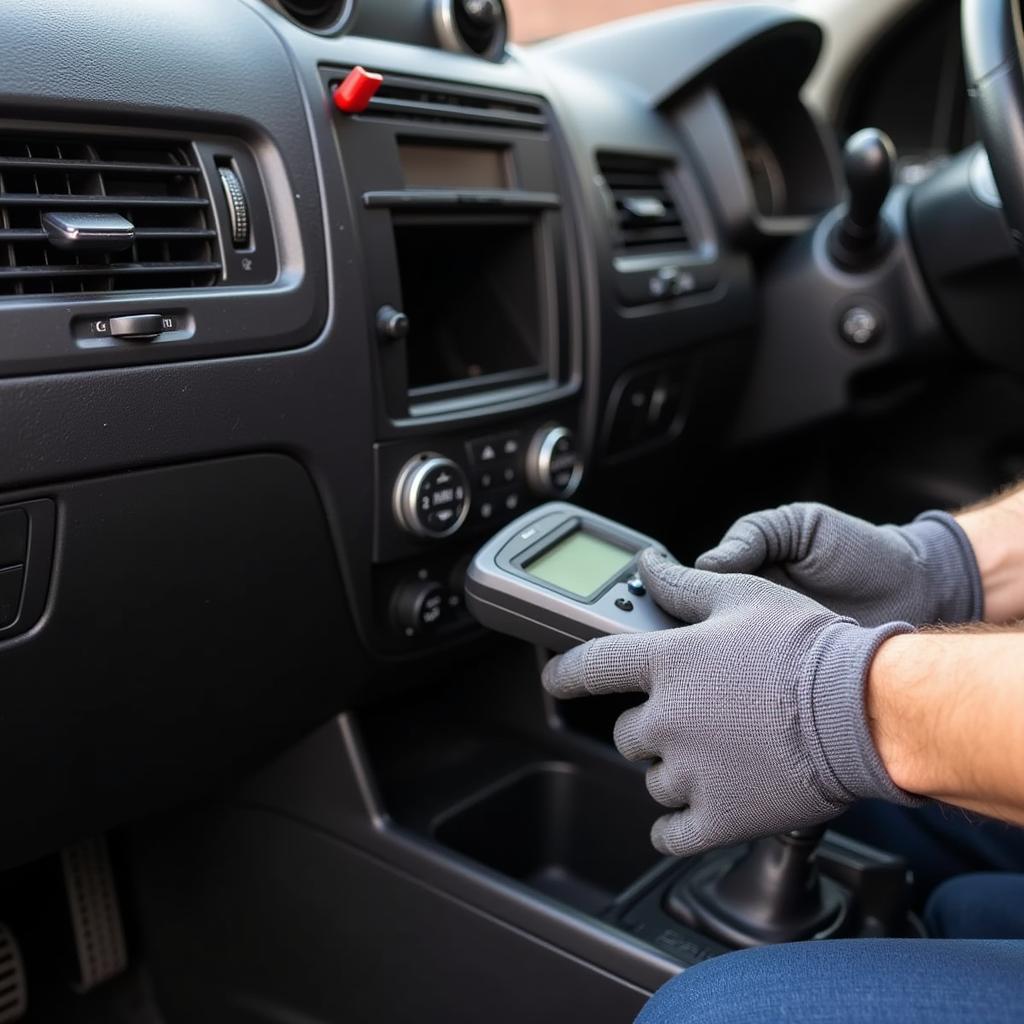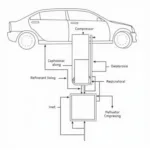Navigating the world of car repair can feel overwhelming, especially for those who love to tinker with their own vehicles. Luckily, OBD (On-Board Diagnostics) diagnostic tools have revolutionized the DIY car repair experience. These handy devices provide a window into your vehicle’s computer system, allowing you to diagnose issues, read error codes, and monitor performance – all from the comfort of your own garage. But with so many options flooding the market, finding the best OBD diagnostic tools for your needs can be challenging. That’s where this comprehensive guide comes in handy.
Understanding OBD Diagnostic Tools and Their Importance for DIY Car Repairs
Before we delve into the top picks, let’s understand what OBD diagnostic tools are and why they’re crucial for the modern DIY mechanic. In essence, these tools act as a bridge between your car’s computer and your smartphone or tablet, translating complex data into understandable information.
By plugging into your vehicle’s OBD-II port (usually located under the driver’s side dashboard), these tools grant access to a treasure trove of data, including:
- Reading and clearing Diagnostic Trouble Codes (DTCs): Imagine this: your check engine light flashes ominously. Instead of rushing to a mechanic, an OBD tool empowers you to identify the issue by reading the DTC. Even better, you can clear the code after resolving the problem, saving you potential diagnostic fees.
- Monitoring live data streams: Ever wondered about your car’s real-time performance parameters? OBD tools offer insights into engine RPM, coolant temperature, oxygen sensor readings, and more, allowing you to monitor performance and identify potential issues before they escalate.
- Performing component tests: Some advanced OBD tools enable you to test specific components like solenoids, actuators, and sensors, providing a more comprehensive diagnostic approach.
Choosing the Right OBD Diagnostic Tool: Key Factors to Consider
With countless OBD diagnostic tools vying for your attention, selecting the right one requires understanding your specific needs and priorities. Here are key factors to guide your decision:
1. Vehicle Compatibility:
- OBD-II vs. Manufacturer-Specific Protocols: While most modern vehicles manufactured after 1996 adhere to the OBD-II standard, some manufacturers employ their own protocols. Ensure the tool you choose supports your vehicle’s make, model, and year, especially if you own an older car or a model with unique diagnostic requirements.
2. Functionality and Features:
- Basic Code Readers vs. Advanced Scan Tools: Define your diagnostic needs. Do you primarily need to read and clear DTCs, or are you looking for more in-depth analysis and functionality? Basic code readers are budget-friendly and sufficient for simple diagnostics, while advanced scan tools offer live data, graphing, component testing, and more.
3. Connectivity and User Interface:
- Bluetooth, Wi-Fi, or USB: Consider how you prefer to connect the tool to your smartphone or tablet. Bluetooth offers wireless convenience, while Wi-Fi often provides faster data transfer speeds. USB connections are reliable but might limit mobility.
- App Compatibility and User Experience: A user-friendly app interface is crucial for seamless navigation and data interpretation. Explore reviews and app demos to ensure the tool’s software aligns with your preferences.
4. Budget and Brand Reputation:
- Balancing Cost and Value: OBD diagnostic tools span a wide price range. Determine your budget and prioritize features that offer the most value for your needs.
- Researching Reputable Brands: Opting for established brands known for quality and reliability ensures accurate results and long-term performance.
Top OBD Diagnostic Tools for Car DIY Enthusiasts in the 4×4 Community
Now, let’s explore some of the best OBD diagnostic tools tailored for DIY car enthusiasts, with a special focus on features beneficial for the 4×4 community:
1. [Insert Brand and Model]: A Robust Option for Serious Off-Roading
This tool excels in providing comprehensive diagnostics and advanced features crucial for demanding 4×4 adventures.
Key Features:
- Extensive Vehicle Coverage: Supports a wide range of makes and models, including popular 4×4 brands.
- Bi-Directional Controls: Enables active testing of components like fuel injectors and ABS modules, vital for diagnosing issues specific to off-road driving conditions.
- Rugged Design: Built to withstand the rigors of off-road use, ensuring durability and reliability.
Expert Insight:
“When venturing off the beaten path, having a reliable diagnostic tool is paramount. The [Insert Brand and Model] offers peace of mind with its robust functionality and durable construction.” – [Insert Expert Name], Certified Automotive Technician and Off-Roading Enthusiast
2. [Insert Brand and Model]: Budget-Friendly Choice with Essential Features
For DIYers seeking a balance between affordability and functionality, the [Insert Brand and Model] delivers essential features without breaking the bank.
Key Features:
- User-Friendly Interface: Intuitive app design makes it easy to navigate menus, read codes, and interpret data.
- Live Data Monitoring: Allows for real-time monitoring of critical engine parameters, particularly useful for monitoring engine performance during off-road excursions.
- Code Library: Provides detailed descriptions of DTCs, eliminating the need for separate lookups.
3. [Insert Brand and Model]: Wireless Wonder for Seamless Diagnostics
This wireless OBD diagnostic tool offers convenience and advanced features, making it an excellent choice for tech-savvy DIYers.
Key Features:
- Bluetooth Connectivity: Enables wireless communication with your smartphone or tablet, offering freedom of movement while diagnosing.
- Customizable Dashboards: Allows you to create personalized displays of vital engine parameters, catering to specific 4×4 monitoring needs.
- Data Logging and Sharing: Record and share diagnostic data for further analysis or consultation with experts.
Conclusion
Equipping yourself with the right OBD diagnostic tool can empower you to take control of your car repairs, saving time and money while gaining valuable insights into your vehicle’s health. By carefully considering your needs, budget, and the factors outlined in this guide, you can confidently choose the best OBD diagnostic tool to tackle any car repair challenge that comes your way.
Remember, informed DIY car maintenance starts with the right tools and a thirst for knowledge.
FAQs
1. Are OBD diagnostic tools universal?
While most modern vehicles utilize the OBD-II standard, compatibility can vary. It’s crucial to verify tool compatibility with your vehicle’s make, model, and year.
2. Can I use an OBD diagnostic tool to program keys or reset my car’s computer?
Basic OBD tools primarily focus on reading and clearing codes. Advanced functionalities like key programming or ECU resets typically require specialized tools.
3. What is the difference between a code reader and a scan tool?
Code readers primarily focus on retrieving and clearing DTCs, while scan tools offer more comprehensive diagnostics, including live data monitoring, component testing, and advanced functionalities.
4. How often should I use an OBD diagnostic tool?
It’s a good practice to periodically scan your vehicle for codes, especially if you notice unusual performance or warning lights. Regular monitoring helps identify potential issues early on.
5. Where can I find reliable information about my vehicle’s specific DTCs?
Reputable online resources, automotive forums, and your vehicle’s service manual can provide detailed information about specific DTCs.
Need help choosing the right OBD diagnostic tool for your needs? Contact our team of experts via WhatsApp: +1(641)206-8880, Email: [email protected]. We offer 24/7 support to help you make informed decisions.



